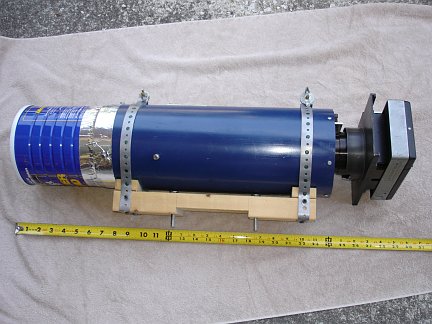 This is an astrographic camera I built many years ago using the lens out of an old Opaque Projector
and a Polaroid oscilloscope camera. It produced instant, large-format astrophotos. I used a piece
of 6 inch PVC pipe for the body of the camera and an old coffee can with both ends cut off can as
a dew shield. The lid of the coffee can served as a dust cap. The wooden frame allowed me to bolt
the camera onto my old Criterion equatorial mount so the camera would track during long exposures.
It produced 3 inch by 4 inch instant Polaroid photos. By a strange coincidence, the scale of the
photos produced by this camera was exactly the same as the scale of my deluxe, desk edition of the
Tirion Sky Atlas 2000 star charts. I can't find any of the photos I took with this astro camera
(it was many years ago). I know they are still here somewhere (since I never throw anything away).
If I ever find them, I'll scan and post a few.
This is an astrographic camera I built many years ago using the lens out of an old Opaque Projector
and a Polaroid oscilloscope camera. It produced instant, large-format astrophotos. I used a piece
of 6 inch PVC pipe for the body of the camera and an old coffee can with both ends cut off can as
a dew shield. The lid of the coffee can served as a dust cap. The wooden frame allowed me to bolt
the camera onto my old Criterion equatorial mount so the camera would track during long exposures.
It produced 3 inch by 4 inch instant Polaroid photos. By a strange coincidence, the scale of the
photos produced by this camera was exactly the same as the scale of my deluxe, desk edition of the
Tirion Sky Atlas 2000 star charts. I can't find any of the photos I took with this astro camera
(it was many years ago). I know they are still here somewhere (since I never throw anything away).
If I ever find them, I'll scan and post a few.
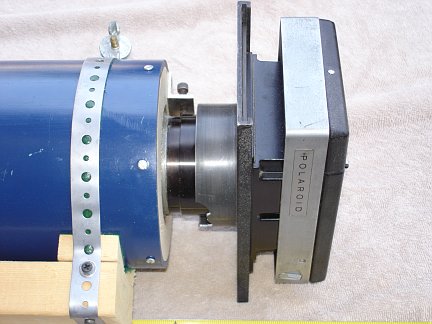 Here is a close-up photo of the Polaroid oscilloscope camera body. Oscilloscope cameras were used
to photograph the trace on an oscilloscope screen in the days before storage oscilloscopes.
The camera uses 3 inch by 4 inch Polaroid
instant film cartridges. I always had a lot of trouble focusing this camera. The camera body screws
in and out of the main tube on very fine threads. I used an empty film cartridge with a piece of
ground glass glued into it at the focal plane as a focusing aid. I also used a coffee can lid painted
flat black with two holes cut into it in front of the lens. With this setup, when pointed at a bright
star, inside or outside of focus there would be two stars. At focus there would only be one star. I
spent many nights on my knees, contorted into strange positions, to get at the focusing screen with
a magnifying loupe to try and focus the camera. The high speed of the camera though made critical focusing
difficult. The depth of field is very small. I only ever managed to get a few photos with decent focus.
Here is a close-up photo of the Polaroid oscilloscope camera body. Oscilloscope cameras were used
to photograph the trace on an oscilloscope screen in the days before storage oscilloscopes.
The camera uses 3 inch by 4 inch Polaroid
instant film cartridges. I always had a lot of trouble focusing this camera. The camera body screws
in and out of the main tube on very fine threads. I used an empty film cartridge with a piece of
ground glass glued into it at the focal plane as a focusing aid. I also used a coffee can lid painted
flat black with two holes cut into it in front of the lens. With this setup, when pointed at a bright
star, inside or outside of focus there would be two stars. At focus there would only be one star. I
spent many nights on my knees, contorted into strange positions, to get at the focusing screen with
a magnifying loupe to try and focus the camera. The high speed of the camera though made critical focusing
difficult. The depth of field is very small. I only ever managed to get a few photos with decent focus.
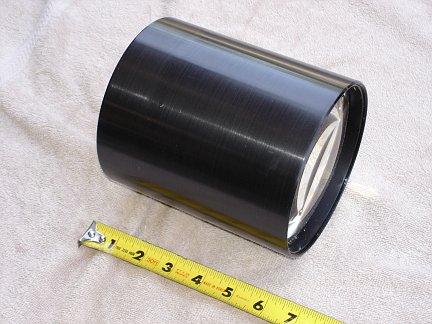 Here is a photo of the big lens removed from the camera. This lens was originally used in an Opaque
Projector I bought at a school surplus auction many years ago thinking it might someday be useful.
The lens is a serious piece of optics. It is 6 1/8 inches long and 5 3/8 inches in diameter, and
weighs about 10 lbs. I took it apart once just to see how it is built. I had to make my own spanner
wrench to get the end ring off. That is a story in itself. Anyway, the lens has three elements,
two of which are doublets. They are the largest lenses I have ever seen. The astrocamera is no
more, but I still have the lens. I just can't stand to part with it. It may find its way into
another project in the future. I may also take it apart again and test the two doublet elements
to see if they would be of any use in a visual refractor. Probably not, but you never know until
you try. The lens as it is would also provide a huge, wide-field view for a modern CCD camera.
So I have a feeling there is a future for this lens after the astrograph.
Here is a photo of the big lens removed from the camera. This lens was originally used in an Opaque
Projector I bought at a school surplus auction many years ago thinking it might someday be useful.
The lens is a serious piece of optics. It is 6 1/8 inches long and 5 3/8 inches in diameter, and
weighs about 10 lbs. I took it apart once just to see how it is built. I had to make my own spanner
wrench to get the end ring off. That is a story in itself. Anyway, the lens has three elements,
two of which are doublets. They are the largest lenses I have ever seen. The astrocamera is no
more, but I still have the lens. I just can't stand to part with it. It may find its way into
another project in the future. I may also take it apart again and test the two doublet elements
to see if they would be of any use in a visual refractor. Probably not, but you never know until
you try. The lens as it is would also provide a huge, wide-field view for a modern CCD camera.
So I have a feeling there is a future for this lens after the astrograph.
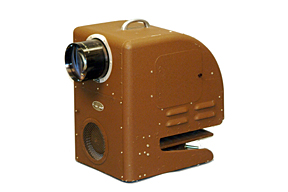 For anyone who doesn't know what an opaque projector is, here is a photo of one. This is very
similar to the one the above lens came from. The function of an opaque projector is to project
images of opaque objects onto a screen (as opposed to transparency projectors like the ubiquitous
overhead projector found in millions of offices and classrooms). Typically a book or other opaque
object with text or artwork on it would be slid into the projector and an image would then be
projected onto a screen for the whole class to see. Opaque projectors were always rare. While
every classroom might have an overhead projector, there might only be one opaque projector per
school. Now that they are obsolete, they are even more rare. These days a webcam, a lamp and
a video projector can do the same job and a lot of others too, and not weigh a ton like the old
single-purpose opaque projectors. These things really were huge, heavy, bulky and built like
tanks. Pretty much everyone is glad to be rid of them.
For anyone who doesn't know what an opaque projector is, here is a photo of one. This is very
similar to the one the above lens came from. The function of an opaque projector is to project
images of opaque objects onto a screen (as opposed to transparency projectors like the ubiquitous
overhead projector found in millions of offices and classrooms). Typically a book or other opaque
object with text or artwork on it would be slid into the projector and an image would then be
projected onto a screen for the whole class to see. Opaque projectors were always rare. While
every classroom might have an overhead projector, there might only be one opaque projector per
school. Now that they are obsolete, they are even more rare. These days a webcam, a lamp and
a video projector can do the same job and a lot of others too, and not weigh a ton like the old
single-purpose opaque projectors. These things really were huge, heavy, bulky and built like
tanks. Pretty much everyone is glad to be rid of them.
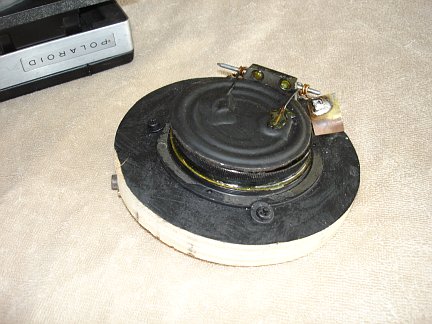 Here is a picture of the shutter assembly I built for the astrocamera. The oscilloscope camera
originally had its shutter in its own lens. That lens had to be removed though to use the camera
body with the big opaque projector lens. So I had to build a new shutter assembly. It is simply
a round disk of sheet metal (the end of a tin can) with black felt on it that covers the opening
to the camera body. The disk is hinged and spring-loaded so that is normally held closed. A metal
tab on one side sits over a hole in the wooden bulkhead. A metal rod inserted through the hole
pushes up the tab and opens the shutter. Removing the rod allowed the spring-loading to close the
shutter. Below is a photo of the shutter in the open position.
Here is a picture of the shutter assembly I built for the astrocamera. The oscilloscope camera
originally had its shutter in its own lens. That lens had to be removed though to use the camera
body with the big opaque projector lens. So I had to build a new shutter assembly. It is simply
a round disk of sheet metal (the end of a tin can) with black felt on it that covers the opening
to the camera body. The disk is hinged and spring-loaded so that is normally held closed. A metal
tab on one side sits over a hole in the wooden bulkhead. A metal rod inserted through the hole
pushes up the tab and opens the shutter. Removing the rod allowed the spring-loading to close the
shutter. Below is a photo of the shutter in the open position.
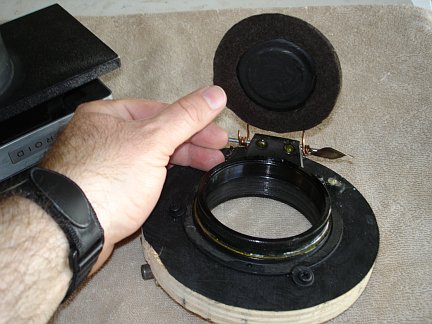 Here is a photo of the shutter open. You can see the ring of black felt that makes a light-tight
seal when the shutter is closed. In operation I would hold my hat in front of the camera
and insert a brass rod into a hole in the back of the camera to open the shutter.
Once the camera stopped jiggling, I'd remove my hat from in front of the camera and start the
exposure. At the end of the exposure I'd once again hold my hat in front of the camera and pull
out the rod closing the shutter. Later I found a camera cable release with a very long plunger
movement. I replaced the brass rod with this cable release, but still used the
"Hat Trick" to prevent jiggling when the shutter opened or closed from smearing the
star images on the film.
Here is a photo of the shutter open. You can see the ring of black felt that makes a light-tight
seal when the shutter is closed. In operation I would hold my hat in front of the camera
and insert a brass rod into a hole in the back of the camera to open the shutter.
Once the camera stopped jiggling, I'd remove my hat from in front of the camera and start the
exposure. At the end of the exposure I'd once again hold my hat in front of the camera and pull
out the rod closing the shutter. Later I found a camera cable release with a very long plunger
movement. I replaced the brass rod with this cable release, but still used the
"Hat Trick" to prevent jiggling when the shutter opened or closed from smearing the
star images on the film.
I would rank this as one of my less successful projects. It all worked, but it was very difficult
to use (especially difficult to focus) and never really produced spectacular photos, at least not
spectacular enough to justify all the effort it took to use the astrograph. I suspect the
Polaroid oscilloscope camera film suffered from extreme reciprocity failure during the long
exposures necessary for astrophotography. The film was also very expensive and hard to find.
Eventually I gave up on this project. It sat in a closet for years and eventually I disassembled
it during one of my rare purges of old junk and tossed out most of the pieces. I still have the
big opaque projector lens and a few other bits though. They may live again in a future project.
 This is an astrographic camera I built many years ago using the lens out of an old Opaque Projector
and a Polaroid oscilloscope camera. It produced instant, large-format astrophotos. I used a piece
of 6 inch PVC pipe for the body of the camera and an old coffee can with both ends cut off can as
a dew shield. The lid of the coffee can served as a dust cap. The wooden frame allowed me to bolt
the camera onto my old Criterion equatorial mount so the camera would track during long exposures.
It produced 3 inch by 4 inch instant Polaroid photos. By a strange coincidence, the scale of the
photos produced by this camera was exactly the same as the scale of my deluxe, desk edition of the
Tirion Sky Atlas 2000 star charts. I can't find any of the photos I took with this astro camera
(it was many years ago). I know they are still here somewhere (since I never throw anything away).
If I ever find them, I'll scan and post a few.
This is an astrographic camera I built many years ago using the lens out of an old Opaque Projector
and a Polaroid oscilloscope camera. It produced instant, large-format astrophotos. I used a piece
of 6 inch PVC pipe for the body of the camera and an old coffee can with both ends cut off can as
a dew shield. The lid of the coffee can served as a dust cap. The wooden frame allowed me to bolt
the camera onto my old Criterion equatorial mount so the camera would track during long exposures.
It produced 3 inch by 4 inch instant Polaroid photos. By a strange coincidence, the scale of the
photos produced by this camera was exactly the same as the scale of my deluxe, desk edition of the
Tirion Sky Atlas 2000 star charts. I can't find any of the photos I took with this astro camera
(it was many years ago). I know they are still here somewhere (since I never throw anything away).
If I ever find them, I'll scan and post a few.
 Here is a close-up photo of the Polaroid oscilloscope camera body. Oscilloscope cameras were used
to photograph the trace on an oscilloscope screen in the days before storage oscilloscopes.
The camera uses 3 inch by 4 inch Polaroid
instant film cartridges. I always had a lot of trouble focusing this camera. The camera body screws
in and out of the main tube on very fine threads. I used an empty film cartridge with a piece of
ground glass glued into it at the focal plane as a focusing aid. I also used a coffee can lid painted
flat black with two holes cut into it in front of the lens. With this setup, when pointed at a bright
star, inside or outside of focus there would be two stars. At focus there would only be one star. I
spent many nights on my knees, contorted into strange positions, to get at the focusing screen with
a magnifying loupe to try and focus the camera. The high speed of the camera though made critical focusing
difficult. The depth of field is very small. I only ever managed to get a few photos with decent focus.
Here is a close-up photo of the Polaroid oscilloscope camera body. Oscilloscope cameras were used
to photograph the trace on an oscilloscope screen in the days before storage oscilloscopes.
The camera uses 3 inch by 4 inch Polaroid
instant film cartridges. I always had a lot of trouble focusing this camera. The camera body screws
in and out of the main tube on very fine threads. I used an empty film cartridge with a piece of
ground glass glued into it at the focal plane as a focusing aid. I also used a coffee can lid painted
flat black with two holes cut into it in front of the lens. With this setup, when pointed at a bright
star, inside or outside of focus there would be two stars. At focus there would only be one star. I
spent many nights on my knees, contorted into strange positions, to get at the focusing screen with
a magnifying loupe to try and focus the camera. The high speed of the camera though made critical focusing
difficult. The depth of field is very small. I only ever managed to get a few photos with decent focus.
 Here is a photo of the big lens removed from the camera. This lens was originally used in an Opaque
Projector I bought at a school surplus auction many years ago thinking it might someday be useful.
The lens is a serious piece of optics. It is 6 1/8 inches long and 5 3/8 inches in diameter, and
weighs about 10 lbs. I took it apart once just to see how it is built. I had to make my own spanner
wrench to get the end ring off. That is a story in itself. Anyway, the lens has three elements,
two of which are doublets. They are the largest lenses I have ever seen. The astrocamera is no
more, but I still have the lens. I just can't stand to part with it. It may find its way into
another project in the future. I may also take it apart again and test the two doublet elements
to see if they would be of any use in a visual refractor. Probably not, but you never know until
you try. The lens as it is would also provide a huge, wide-field view for a modern CCD camera.
So I have a feeling there is a future for this lens after the astrograph.
Here is a photo of the big lens removed from the camera. This lens was originally used in an Opaque
Projector I bought at a school surplus auction many years ago thinking it might someday be useful.
The lens is a serious piece of optics. It is 6 1/8 inches long and 5 3/8 inches in diameter, and
weighs about 10 lbs. I took it apart once just to see how it is built. I had to make my own spanner
wrench to get the end ring off. That is a story in itself. Anyway, the lens has three elements,
two of which are doublets. They are the largest lenses I have ever seen. The astrocamera is no
more, but I still have the lens. I just can't stand to part with it. It may find its way into
another project in the future. I may also take it apart again and test the two doublet elements
to see if they would be of any use in a visual refractor. Probably not, but you never know until
you try. The lens as it is would also provide a huge, wide-field view for a modern CCD camera.
So I have a feeling there is a future for this lens after the astrograph.
 For anyone who doesn't know what an opaque projector is, here is a photo of one. This is very
similar to the one the above lens came from. The function of an opaque projector is to project
images of opaque objects onto a screen (as opposed to transparency projectors like the ubiquitous
overhead projector found in millions of offices and classrooms). Typically a book or other opaque
object with text or artwork on it would be slid into the projector and an image would then be
projected onto a screen for the whole class to see. Opaque projectors were always rare. While
every classroom might have an overhead projector, there might only be one opaque projector per
school. Now that they are obsolete, they are even more rare. These days a webcam, a lamp and
a video projector can do the same job and a lot of others too, and not weigh a ton like the old
single-purpose opaque projectors. These things really were huge, heavy, bulky and built like
tanks. Pretty much everyone is glad to be rid of them.
For anyone who doesn't know what an opaque projector is, here is a photo of one. This is very
similar to the one the above lens came from. The function of an opaque projector is to project
images of opaque objects onto a screen (as opposed to transparency projectors like the ubiquitous
overhead projector found in millions of offices and classrooms). Typically a book or other opaque
object with text or artwork on it would be slid into the projector and an image would then be
projected onto a screen for the whole class to see. Opaque projectors were always rare. While
every classroom might have an overhead projector, there might only be one opaque projector per
school. Now that they are obsolete, they are even more rare. These days a webcam, a lamp and
a video projector can do the same job and a lot of others too, and not weigh a ton like the old
single-purpose opaque projectors. These things really were huge, heavy, bulky and built like
tanks. Pretty much everyone is glad to be rid of them.
 Here is a picture of the shutter assembly I built for the astrocamera. The oscilloscope camera
originally had its shutter in its own lens. That lens had to be removed though to use the camera
body with the big opaque projector lens. So I had to build a new shutter assembly. It is simply
a round disk of sheet metal (the end of a tin can) with black felt on it that covers the opening
to the camera body. The disk is hinged and spring-loaded so that is normally held closed. A metal
tab on one side sits over a hole in the wooden bulkhead. A metal rod inserted through the hole
pushes up the tab and opens the shutter. Removing the rod allowed the spring-loading to close the
shutter. Below is a photo of the shutter in the open position.
Here is a picture of the shutter assembly I built for the astrocamera. The oscilloscope camera
originally had its shutter in its own lens. That lens had to be removed though to use the camera
body with the big opaque projector lens. So I had to build a new shutter assembly. It is simply
a round disk of sheet metal (the end of a tin can) with black felt on it that covers the opening
to the camera body. The disk is hinged and spring-loaded so that is normally held closed. A metal
tab on one side sits over a hole in the wooden bulkhead. A metal rod inserted through the hole
pushes up the tab and opens the shutter. Removing the rod allowed the spring-loading to close the
shutter. Below is a photo of the shutter in the open position.
 Here is a photo of the shutter open. You can see the ring of black felt that makes a light-tight
seal when the shutter is closed. In operation I would hold my hat in front of the camera
and insert a brass rod into a hole in the back of the camera to open the shutter.
Once the camera stopped jiggling, I'd remove my hat from in front of the camera and start the
exposure. At the end of the exposure I'd once again hold my hat in front of the camera and pull
out the rod closing the shutter. Later I found a camera cable release with a very long plunger
movement. I replaced the brass rod with this cable release, but still used the
"Hat Trick" to prevent jiggling when the shutter opened or closed from smearing the
star images on the film.
Here is a photo of the shutter open. You can see the ring of black felt that makes a light-tight
seal when the shutter is closed. In operation I would hold my hat in front of the camera
and insert a brass rod into a hole in the back of the camera to open the shutter.
Once the camera stopped jiggling, I'd remove my hat from in front of the camera and start the
exposure. At the end of the exposure I'd once again hold my hat in front of the camera and pull
out the rod closing the shutter. Later I found a camera cable release with a very long plunger
movement. I replaced the brass rod with this cable release, but still used the
"Hat Trick" to prevent jiggling when the shutter opened or closed from smearing the
star images on the film.